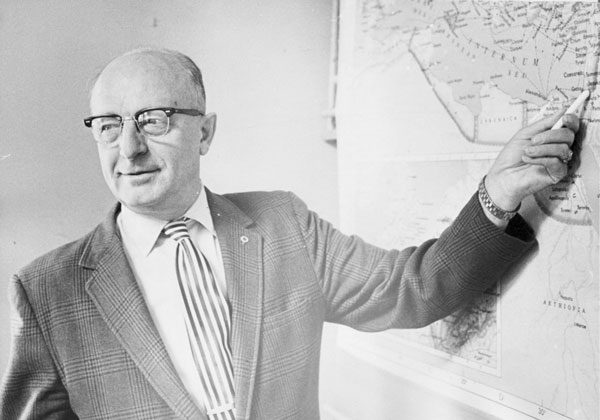December 31, 2017
|
 The 1833 General Conference provided for establishing a United Brethren publishing house. It took shape in May 1834 in Circleville, Ohio, under the sponsorship of Scioto Conference. William Rinehart, a United Brethren minister in Virginia Conference, had been publishing a paper on his own press called The Mountain Messenger. Scioto asked Rhinehart to move to Circleville to become editor of a United Brethren publication, and they even bought out his little paper.
The 1833 General Conference provided for establishing a United Brethren publishing house. It took shape in May 1834 in Circleville, Ohio, under the sponsorship of Scioto Conference. William Rinehart, a United Brethren minister in Virginia Conference, had been publishing a paper on his own press called The Mountain Messenger. Scioto asked Rhinehart to move to Circleville to become editor of a United Brethren publication, and they even bought out his little paper.
On December 31, 1834, the first issue of The Religious Telescope was published. It was four pages long, 15-by-22 inches in size. It began as a bi-monthly publication, and started with about 1200 subscribers who paid $1.50 per year. We now had a denominational publication.
John Lawrence, who would become editor in 1852, wrote, “The paper was a very respectable sheet, well edited, yet not popular because of the extreme views which it advocated. It entered largely into the controversies of the times and earnestly and boldly, though not always prudently, marched in the front ranks of every reform.”
Most of the original United Brethren spoke German, and the German language predominated in United Brethren circles into the 1830s. Only two members of the 1821 General Conference were English. Others could preach in English, but German was their mother tongue. The 1821 Discipline was printed in both languages—German on the left, English on the right. It was an acknowledgement of what was coming.
The Germans, because of their unselfish missionary zeal, pretty much worked themselves out of a denomination. They so generously supported and promoted outreach to English people that by the 1830s, we had become (or were becoming) a predominantly English-speaking church. Most of the church’s expansion into the west–Ohio, Indiana, and elsewhere–occurred among English-speaking people.
From the beginning, The Religious Telescope was published in English. However, because of protests from some German-speaking folks that scant attention was being given to the German constituency, we launched a German-language periodical called Die Geschaftige Martha (The Busy Martha). It started in 1840, but ceased after two years. English, even in Pennsylvania, was clearly the future.
In 1885, seeing The Religious Telescope dominated by liberal voices, Milton Wright and others launched an alternative paper. They considered calling it The United Brethren, but instead settled on The Christian Conservator. When Wright’s followers split off, The Christian Conservator became the official publication of the “radical” United Brethren denomination. Its name was changed to The United Brethren in 1954. The magazine was discontinued in 1993.
The Religious Telescope continued until 1946, when the “liberal” UBs merged with the Evangelical Association, which had its own publication called The Evangelical Messenger. The new denomination, called the Evangelical United Brethren Church, merged the two periodicals under the very uncreative name The Telscope-Messenger.
 Randy Carpenter (right) was hired as a staff pastor at Colwood UB church (Caro, Mich.) effective January 1, 2018. He was previously senior pastor of Sunfield UB church (Sunfield, Mich.). Colwood is using a team approach, with three persons–Mike Whipple, Kelly Ball, and Carpenter–listed as teaching pastors. Each also carries other areas of responsibility. For Carpenter, the website lists assimilation and discipleship.
Randy Carpenter (right) was hired as a staff pastor at Colwood UB church (Caro, Mich.) effective January 1, 2018. He was previously senior pastor of Sunfield UB church (Sunfield, Mich.). Colwood is using a team approach, with three persons–Mike Whipple, Kelly Ball, and Carpenter–listed as teaching pastors. Each also carries other areas of responsibility. For Carpenter, the website lists assimilation and discipleship.


 Linda Carter, wife of Rev. Al Carter, passed away around 11 am on Friday, January 5, 2018. She was in hospice after a battle with cancer. Her husband has been pastor of First UB (Columbus, Ohio) since 2011. They previously served UB churches in St. Mary’s and Rockbridge, Ohio.
Linda Carter, wife of Rev. Al Carter, passed away around 11 am on Friday, January 5, 2018. She was in hospice after a battle with cancer. Her husband has been pastor of First UB (Columbus, Ohio) since 2011. They previously served UB churches in St. Mary’s and Rockbridge, Ohio.
 The 1833 General Conference provided for establishing a United Brethren publishing house. It took shape in May 1834 in Circleville, Ohio, under the sponsorship of Scioto Conference. William Rinehart, a United Brethren minister in Virginia Conference, had been publishing a paper on his own press called The Mountain Messenger. Scioto asked Rhinehart to move to Circleville to become editor of a United Brethren publication, and they even bought out his little paper.
The 1833 General Conference provided for establishing a United Brethren publishing house. It took shape in May 1834 in Circleville, Ohio, under the sponsorship of Scioto Conference. William Rinehart, a United Brethren minister in Virginia Conference, had been publishing a paper on his own press called The Mountain Messenger. Scioto asked Rhinehart to move to Circleville to become editor of a United Brethren publication, and they even bought out his little paper.

